Ramayana
APPROACHING THE ADI-KAVI
APPROACHING ADI-KAVI VALMIKI[i]
Pradip Bhattacharya
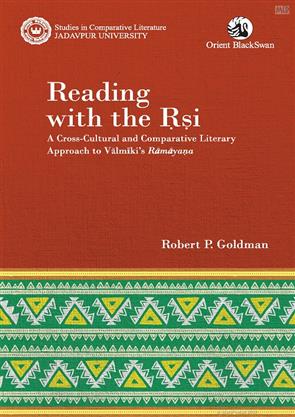
The Department of Comparative Literature of Jadavpur University founded by the litterateur Buddhadeb Bose in 1956 was the first such in India. It has now embarked upon an ambitious project: a series of research publications in four categories, viz. Texts, Contexts, Methods; Indian and Asian Contexts; Literature and Other Knowledge Systems; and Lecture Series. The overpriced slim volume under review belongs to the last category. From the editors’ Introduction it seems that Goldman did not deliver this lecture but sent it as a written contribution. This is a pity, because documented interaction with an audience would have made it a far more significant publication. This extremely well-written “lecture” is not much more than an introduction for beginners, albeit a very competent one, to Valmiki’s work and hardly falls under the rubric of “research”.
The Ramayana (R) presents specific hurdles before the modern reader: it depicts a civilization of circa the first millennium BCE far removed from us; its language is ancient Sanskrit, which is not easily accessible. Further, Sanskrit did not have a principal script universally used. The R has spawned widely varying versions in almost all languages and different scripts of South and Southeast Asia “from Afghanistan to Bali” and is depicted in varied media. Surprisingly, Goldman makes no reference to the Belgian priest Camille Bulcke’s encyclopaedic Hindi study of these variations.[ii]
Adopting the linguist Kenneth Pike’s terms emic (subjective) and etic (objective), Goldman identifies two types of group-approaches to the R. In the former, fall variations in Indian languages and media. The latter is consists of scholarly studies in various disciplines world-wide, including translations in non-Indian languages.
Goldman asserts that the presumption of a single divinely inspired composer disseminating his composition through twin rhapsodes who recited it in toto before the public is a myth. The text would have undergone changes on the lips of differing bards and redacteurs owing to lapses in memory and improvisations responding to the changing audience and place. We can witness this phenomenon today in the “Pandavani” folk retellings of the Mahabharata (M) in Central India. Those Ramayana rhapsodes were given the collective name, “Valmiki”. Thus, like many Western Mahabharata scholars who dismiss Vyasa as a myth, Goldman denies the existence of Valmiki.
Further, he denies the possibility of so bulky a work being transmitted orally from Afghanistan to Bali without being reduced to writing, as evinced by innumerable manuscripts in circulation through South and Southeast Asia from about the end of the first millennium CE. Errors and changes occurred while copying a manuscript into different scripts. Thus, between the Northern and the Southern Indian script recensions only about one third are identical. Moreover, within each recension there are regional variations depending on the script in which the copies have been made.
A very important clarification Goldman provides is that the Baroda critical edition of “India’s National Epic” does not represent the original, but seeks to present an archetype constructed out of the best manuscripts that would be nearest to the period of the oldest available manuscripts. The abundance of textual variants poses a major problem in trying to assess the poem’s original form. Goldman hazards a guess that the R was produced around 500-100 BCE, while its oldest manuscripts go back only to the 12th or 13th centuries CE. So we have over 1700 years of no written record of the R. Therefore, “the etic reconstruction of the Ramayana’s genetic history is naturally going to be at odds with its emic receptive history of the work.” While to scholars it is a bardic poem orally performed and transmitted, to its audience it is the work of a single composer, the first poet (adi–kavi), who was a contemporary of Rama in mythical times. An avatar of Vishnu, he descended on earth to destroy demonic oppressors of sages and establish a golden age lasting millennia. Thus, according to the emic view, “it is a chapter of divine history rendered in a new form, that of poetry.” Raising the stimulating question, is the R “a poetic history or a historical poem”, Goldman leaves it hanging in the air. It would have been very interesting to study the reactions of the audience, had this been a live lecture.
Looking into the nature of the R vis-à-vis the M, Goldman notes that the former is far more poetic and emotional than the latter. The predominant emotion of the R is “karuna rasa”, pathos, whereas for the M a new emotion was added by the critic Anandavardhana (c. 9th century CE), “shanta rasa”, worldly-detachment or serenity. Earlier, the poet Bhavabhuti (c. 8th century CE), had asserted that “karuna” is the only rasa. However, in his last work Alf Hiltebeitel has argued very persuasively that the M’s rasa is “adbhuta-wonder”. Where the R holds up a mirror for rulers and families, the M portrays the incredibly complex ramifications of dharma in society and the individual.
Besides ignoring the story of Rama recounted in the M, Goldman has not noticed another structural similarity between the two mahakavyas that young Ramayana aficionado Saikat Mandal has pointed out. The Tilaka commentary on R by Nagoji Bhatta or Ramavarma (1730-1810) glosses the Uttarakanda as the “khila” (supplement) of the R just as the Harivamsha is of the M. The significance of this needs exploration.
Goldman expatiates at length on how the R records the inception of Valmiki’s composition, which is “a later addition to the fully developed work” for establishing it as the divinely inspired first poem. Its list of seven of the eight “rasas” shows it to be later than Bharata’s treatise, Natyashastra. Goldman goes on to show how the R differs from the Homeric epics in characteristics such as rapidity, being plain and direct in syntax, language and thought. He finds Valmiki hyperbolic, using rhetorical figuration aplenty, highly formulaic and repetitive, unlike Homer’s directness. The literary quality of the R is complicated, being a poem to delight while also being a chronicle. Goldman could have noted how, in all these features, the R is similar to the M and also different, as discussed at length by Sri Aurobindo in “Vyasa and Valmiki”.
Further, the R has grammatical forms that violate Panini’s rules and could be seen as poetic flaws. Its first and seventh books are of a later date, in less refined language. Goldman quotes at length from Homer and Valmiki to exemplify his arguments and to show how adept the latter is in portraying beauty in persons and in nature, including the frightful. Pursuing Abhinavagupta’s view of rasadhvani, Goldman analyses how the raw emotion of grief is sublimated by Valmiki to make karuna rasa the major aesthetic flavour of poetic composition, transmuting shoka (grief) to shloka (verse). The climax is reached in ending with Sita’s descent into the depths of the earth, leaving Rama desolate.
[i] Robert P. Goldman: Reading with the Rsi—a cross-cultural and comparative literary approach to Valmiki’s Ramayana. Orient BlackSwan, Hyderabad, 2023, pp. xvii+54, Rs.385/-
[ii] English translation The Rama Story by Pradip Bhattacharya published in 2022 by the Sahitya Akademi.
Book Review of Fr. Camille Bulcke’s THE RAMA STORY: ORIGINS AND GROWTH (2022)
Trans. (from Hindi) by Pradip Bhattacharya. Delhi: Sahitya Akademi. Hardbound.
ISBN: 9789355481108
Oshin Vipra Sagar, Avinash Kumar
Kalākalpa, Vol. VII, No. 2(2023)
With some variation, the story of Rama is told not just across different parts of the Indian subcontinent but also in Southeast Asia with just as much fervour. Not to forget, Ram and his supposed birthplace have become a part of the politico-religious fabric of India over the last few decades. Therefore, a historical inquiry into the story of Rama is a pertinent endeavour now more than ever. However, no systematic historiographical work on Rama’s tales was available for general readers and academics alike until a Belgian Jesuit priest Father Camille Bulcke accomplished the task of comprehensively tracing the origin and development of the narratives around Rama in his magnum opus “Ramkatha: Utpatti Aur Vikas” published in 1950. The work, however, remained accessible only to readers and researchers proficient in Hindi. The translation by Pradip Bhattacharya bridges that gap for the anglophone public through his work ‘The Rama Story: Origins and Growth’, published by Sahitya Akademi in August 2022.
Pradip Bhattacharya’s ambitious translation has surveyed the major available editions of Father Bulcke’s original work. He has taken into cognisance the printer’s gremlins (in the 16th ed.) and tried his best to critically examine the errors and omissions before producing his translation based primarily on the third edition of Bulcke’s work published in 1971 by Hindi Parishad Prakashan, Allahabad University. Bhattacharya also acknowledges the original writer’s lack of awareness of his predecessors’ work relating to Ramayana at large such as those by Akshoy Kumar Maitreya, who, for example, has dealt with the subjects Bulcke deals with (say, Ramayana’s relationship with Greek and Buddhist stories) or Rajasekhara P.Basu’s ‘Surpanakha Reminiscences’ and ‘the Rule of Rama’ or Kumudini’s ‘Sita’s Letters.’
Father Bulcke’s omissions of the verse number and translation of Sanskrit verses too, have been supplemented in the translated work by Bhattacharya, making it fairly corroborated and accessible. Nonetheless, the translator has ensured that they stay true to the original and preserve its appearance while addressing the need to rectify some inconsistencies in referencing style.
‘The Rama Story: Origins and Growth’ wholeheartedly follows the structure of Bulcke’s “Ramkatha: Utpatti Aur Vikas”, wherein the work is divided into four main parts, each corresponding to the four major stages of the evolution and expansion of the Rama story. The first part (consisting of chapters 1 to 5) concerns itself with the extant ancient literature such as the Vedic, Buddhist and Jain corpus – scrutinising the references to the Rama story they present. The first chapter reviews the Vedic literature for the presence of characters like Iksvaku, Dasaratha, Janaka, and Sita as the presiding deity of agriculture while also presenting an apparent absence of Rama in the corpus. The second chapter examines the three recensions of Valmiki’s Ramayana and attempts to gauge the time of its composition historically. It also disambiguates the identity of the author of Ramayana, the poet Valmiki and sheds light on the various Valmikis. The third chapter brings some fascinating insights to the table regarding the timeline of Valmiki’s Ramayana with reference to the other epic of the subcontinent, i.e., the Mahabharata (hence, Mb). Verses from the primary text of Mb have been used to illustrate how the composers of Mb were aware of Valmiki and his work – while maintaining a distinction between the stories of Bharata and the Mahabharata. At the same time, the readers are also provided with quantitative cues to the popularity of the Rama story: for example, how approximately fifty references to Rama or characters related to his story are found in Mb.
In part two of the work, chapter 6 critically examines the origins of the story of Rama: addressing the problematic nature of “Dasaratha Jataka” and the question of the authenticity of the Pali “Jatakakathavannana.” In the consecutive chapter, the discussion follows through on the matter by taking into consideration the views of scholars such as Dr. Weber, Jacobi and Dineshchandra Sen. Chapter 8 and 9 remarks on the main interpolations in Valmiki’s Ramayana and how the concept of the ‘avatar’ contributed to its wide dispersal.
The third part of the book provides an overview of the wide and deep penetration of the Rama story across medieval literature from the subcontinent across Sanskrit, modern Indian languages, and other Asian languages. In this part, chapter 10 elucidates on the development of Rama-bhakti and the Rama stories in Puranic literature (Harivamsa, the Mahapuranas and the minor Purana) as well as the sectarian Ramayanas and other religious literature from the period. The subsequent chapter 11 traces and maps the Rama story across an elaborate list of Sanskrit belle letters beginning with Raghuvamsa, Setubandha and covering about 17 major works, including epic poetry and plays, while further covering some minor works. Chapter 12 of the work is divided into two parts: the first discusses the Ramayana across Southern languages of Tamil, Telugu, Malayalam, and Kannada, including the tribal tales related to Rama from the region; the second discusses the Rama story in the literary works produced in northern Indian languages as well as Sinhalese. The two parts of this chapter correspond to Bulcke’s rough categorisation of linguistic groups as Dravidian and Aaryan, which could be better titled in the translation to be technically more accurate and not appear anachronistic. The last part, chapter 14, discusses the Rama story abroad in the Tibeto-Khotanese, Indonesian, Indo-Chinese (Vietnamese), Siamese and Burmese traditions while briefly touching upon the Western narratives.
The fourth and final part of the book expounds on the growth of the Rama story spread over seven Kandas (Bālakāṇḍa, Ayodhyakāṇḍa, Araṇyakāṇḍa, Kiṣkindakāṇḍa, Sundarākāṇḍa, Yuddhakāṇḍa, Uttarakāṇḍa) in chapters 14-20. It ends with concluding remarks in the 21st and the last chapter of the volume. This part of the book, from pg. 341 to pg. 892 amounts for the bulk of the volume that closely engages in dissecting the minutest details of themes and episodes of each Kanda and the variations of each, if any, across the three recensions of Valmiki’s Ramayana.
As for relevant original additions, Bhattacharya (supplementing Bulcke’s original list) brings to the readers an organised exhaustive bibliography comprising ancient texts as well as modern works across Indian and foreign languages in Appendix I. Appendix II sheds light on the story wherein Rama had to shoot an arrow at Hanuman on Viswamitra’s command, an intriguing episode relating to Rama that Bulcke skipped in his almost encyclopaedic work. In Appendix III, Bhattacharya elucidates on the large yet relatively less-known Ramayana frescoes in the Silver Pagoda at Phnom Penh, Cambodia, commissioned between 1903-04. The frescoes depict the Khmer story of Rama being abducted by Ravana’s nephew Waireab and his rescue by Hanuman. Finally, in Appendix IV, he reviews Paula Richman’s ‘Questioning Ramayana’ and Amreeta Syam’s ‘Kaikeyi.’
Overall, the book is worth all the attention at present and for times to come. Priced at INR 1500/- this 990-page book is a comprehensive wellspring of information on the narratives surrounding the character of Rama, which historically traces their antiquity while critically examining its growth through the ages.
The Rama Story
(Rama-Katha) by Padma Bhushan Camille Bulcke, S.J.
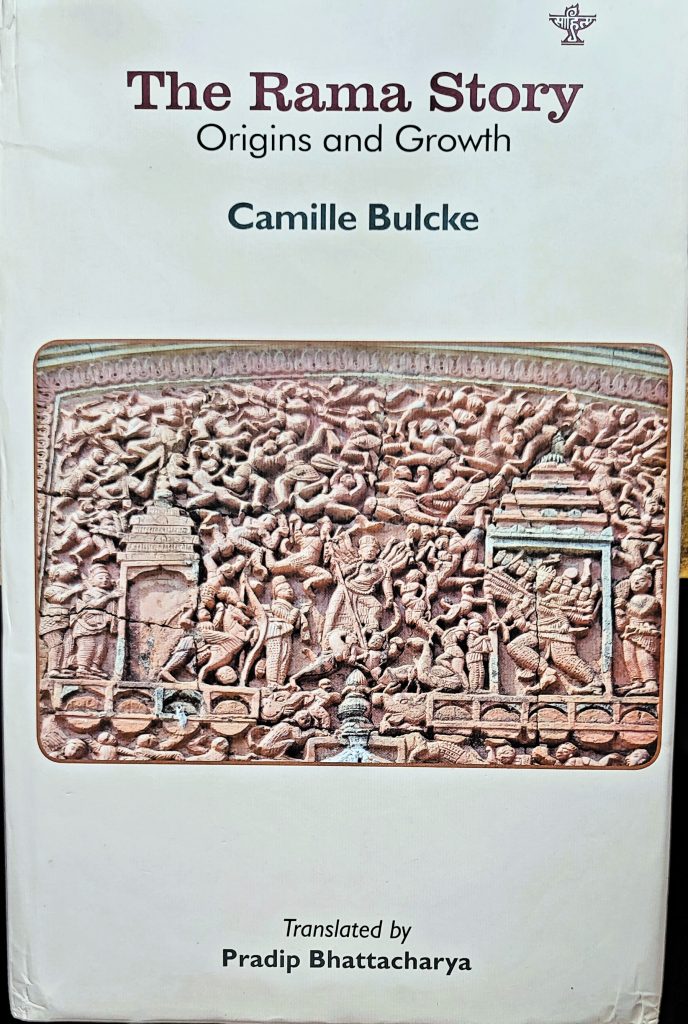
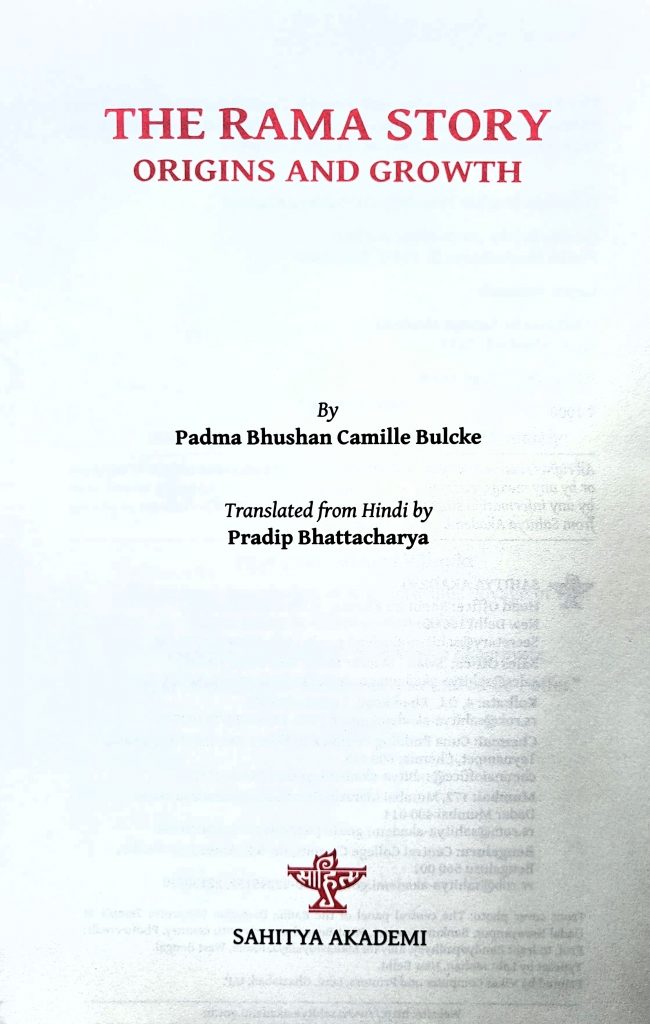

Translated from Hindi by Pradip Bhattacharya
published by Sahitya Akademi
secretary@sahitya-akademi.gov.in
The “Lost” Mahabharata of Jaimini
This paper features on pp. 33-67 of IGNCA’s journal of arts, KALAKALPA, Basant Panchami 2019, vol.III, No.2. The Editor-in-Chief, Dr. Sachchidanand Joshi, Member Secretary of the IGNCA, writes in his editorial, “Professor Pradip Bhattacharya is an acclaimed scholar on Mahabharata…Professor Bhattacharya’s contribution is stupendous.” The paper has been published with 3 colour plates of photographs I took of frescos on the walls of the Silver Pagoda in Phnom Penh, 3.65 metres high, illustrating the episodes contained in these 2 manuscripts of Jaimini which retell unknown episodes from the Ramayana in the Ashramavasika Parva of the Mahabharata.
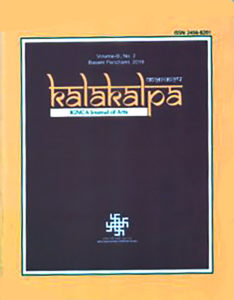
Why is the Ramayana more popular than the Mahabharata?
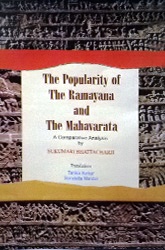 Sukumari Bhattacharji: The Popularity of the Ramayana and the Mahabharata—A Comparative Analysis. Translated by Tanika Sarkar and Somdatta Mandal. Anustup, 2018, pp. 109, Rs.300/-
Sukumari Bhattacharji: The Popularity of the Ramayana and the Mahabharata—A Comparative Analysis. Translated by Tanika Sarkar and Somdatta Mandal. Anustup, 2018, pp. 109, Rs.300/-
The late Sukumari Bhattacharji was one of the rare Sanskrit scholars from India who was equally at home in English. Her The Indian Theogony has been a major reference work for decades and Legends of Devi is a delightful retelling. Possibly her most fascinating Bengali book is a study of why the Ramayana is more popular than the Mahabharata (1996). She asserts, “What we claim as Indian civilization today has The Ramayana at its root and not The Mahabharata.” Unfortunately, till now her trenchant and illuminating analysis has not been available to Indologists all over the globe.
Professor Bhattacharji always wrote to the point, was never guilty of verbiage or of pulling punches. Her professed Marxist bent does not vitiate her incisive and penetrating insights in this book. In the slim compass of just 87 pages she not only provides a parva-wise summary of the world’s longest epic in 15 chapters, but also investigates the elements that make the Ramayana more appealing than the Mahabharata. A splendid achievement, for anyone interested in our epics this is the finest overview. It steers the reader deftly through what Oldenberg called “the monstrous chaos” of the Mahabharata.
The matrix birthing the two epics, according to her, is the crisis of values during the Kushana times (1st-2nd centuries A.D.) with the emergence of small kingdoms and new clans leading to creation of the mahakavyas, the Kamasutra, Manusamhita and some Sanskrit Jataka tales. These dealt with practical issues of the paramountcy of filial duty, familial bonds and loyal friendship, enduring long suffering for the sake of vows etc. The Shanti and Anushasana Parvas are the text needed for the empires that emerged between the Maurya and the Gupta periods. Old values are revised and codified in a collective effort. Bhishma’s advice never to trust a woman “is an attempt to poison men against women” for all time, as post-Gupta society relied on male domination and Shudra servility.
Simultaneously there is Bhishma’s statement, “Nothing is greater than Man,” which Bhattacharji takes to heart as the concluding message of the Mahabharata. Animandavya curses Yama the god of death and Gandhari curses Krishna. “No higher justice governs the world…it depends on mortal beings to ensure justice.” The Ramayana, having no such revolutionary statement, is much more like a fairy-tale, replete with supra-normal events and characters which appeal powerfully to the general public as “Values of domination and subordination come decked out in supernatural mysteries, in a fairy-tale appeal.” With hardly any grey areas, all relationships being simple and linear, “It saves the reader from self-searching and self-doubt.” Above all, it is “suffused with lyrical qualities.” Hence, accepting the protagonists as models poses no problem.
Conversely, the Mahabharata mirrors an age and its peoples, prominently featuring crises of conscience and focusing on the annihilation of entire lineages. The grey areas are pervasive, each episode having complex resonances. Faced with the clash between ends and means people find it deeply disturbing. Bhattacharji cites Shakuntala publicly pouring scorn upon her husband as an example of what readers would have difficulty in accepting. That is why Kalidasa deprived his heroine of this fire. Again, Vyasa himself is a product of rape but there is no condemnation of the rapist rishi. Bhishma tells Draupadi that what the powerful do is considered dharma, i.e. might is right. Such concepts are difficult to digest. Finally, Vyasa’s poetry is far more intellectual than Valmiki’s lyricism, which also detracts from the popularity of the Mahabharata.
Does the reluctance to fight displayed by Yudhishthira and Arjuna reflect the belief in ahimsa propagated by Jains, Buddhists and Ajivikas from the 7th century BC when, according to Bhattacharji, the composition of the epic began? Here, again, the audience faces a dilemma without any clear answer. Confronted with complex problems and ambiguities in life, people long for simple solutions. The Mahabharata creates those very complications, questioning the prevalent belief system, which is why it loses out to the Ramayana in popular appeal.
While discussing Valmiki’s epic, Bhattacharji cannot resist the occasional quip, e.g., how could the two brothers carry adequate weapons for the Lanka battle; men did not have to prove chastity as a masculine equivalent did not exist in Sanskrit; shudras and chandalas were considered subhuman. In the Mahabharata, Arjuna’s mental paralysis is dissipated by “a magical performance” stunning him—and the audience—into submission. Magic, not logic, carries the day! Never has the Gita been accorded such short shrift!
Very perceptively Bhattacharji chooses to discuss Vidura’s parable of the man in the well which, she asserts, is composed after the concepts of Nirvana (Buddhist) and Moksha (Upanishadic). Despite death being the only reality, the persistence of desire keeps life precious as a positive experience although “negation found strong resonance in a class-divided society with a large oppressed population.” She overlooks that the Mahabharata calls itself the Veda for women and shudras too and that this parable found its way into the Bible as the tale of Barlaam and Josaphat. The Ramayana neither presents such conflicts nor does it take us to such great depths.
The Sauptika Parva is omitted from the survey without any explanation. There is a puzzling statement (p.19) that the Ramayana, being unsure of Sita’s chastity, installs Bharata at the end instead of Lava or Kusha. Actually, in the text the brothers and the subjects drown themselves with Rama in the Sarayu, before which Rama installs his sons to rule over northern and southern Kosala. In view of Bhattacharji’s pronounced feminist stance (the first fall and death en route Swarga was of Draupadi because she was a woman, p.63), it is intriguing to find no reference to the mutilation of Ayomukhi (ear, nose, breasts chopped off) and Surpanakha (nose and ears sliced) by Rama and Lakshmana. She asserts (p. 41) that as Kaurava bards sang the events of the Kurukshetra war, it is a partisan narrative making a great hero out of Karna. However, Karna is not a Kaurava at all but Yadava Kunti’s illegitimate son. Further, Rama does not refuse Guhaka’s hospitality because he is chandala (p. 19) but because, having taken to asceticism, he would live only on fruits and roots, as he himself explains.
Bhattacharji declares that the Mausala Parva is interpolated being full of supernatural events, yet she admits that they construct an inevitable sense of waste. She fails to substantiate that it is “not inherently related to the epic” and admits it reflects the wider perspective of destruction caused by war. The uneasiness it creates is the key to its effectiveness. Similarly, she dismisses the entire Bharata Savitri as irrelevant (p.62) although it ends with Vyasa’s remarkable query which remains a riddle for us all: “From Dharma come wealth and pleasure. Why is Dharma not practised?” Here the translators mistranslate “phalashruti” (the benefits of listening to the epic) as “hearsay.”
Bhattacharji, like her colleague Buddhadeb Bose in his The Book of Yudhishthira, establishes Yudhishthira as the epic’s hero the reader’s attention being focused only on him at the end. A deity (Krishna), being superhuman, cannot be the protagonist. Yudhishthira upholds Bhishma’s utterance that nothing is greater than man and would put aside Kshatriya creed in favour of ahimsa. Only a man can show other men the way out in crises. In the Mahabharata a greater idea of virtue and justice is at work. The Ramayana presents no complications over heaven and hell. Its idea of duty is rectilinear. Even in killing Bali and Shambuka, Rama suffers no moral pangs. Towards the end, the Mahabharata says twice that kings have to go to hell, giving no reason (this is from the section Bhattacharji has already rejected, yet she cites it approvingly!). No solution is presented to the clash between a king’s duties and that of humanity. The Ramayana does not perplex or mortify the reader—we are told to behave like Rama. The Mahabharata alone has the protagonist debate with death itself, proving the truth of human worth through all suffering and failures, confronting them and sacrificing the self for the greater good of society. It does not ask us to behave like Krishna to whom it assigns an ignominious death, while sending Yudhishthira triumphantly to Swarga in his mortal frame. Yudhishthira becomes the hero, repeatedly perturbed but achieving a stable world-view at the end.
Devoting an entire chapter to the enigma of Bhishma, she correctly points out that non-involvement characterizes him starting with aloofness during the three year long war in which a Gandharva killed his step-brother Chitrangada. Bhattacharji notes the similarities with Rama who abdicated for his father’s marital bliss. However, Bhishma never asked his father for the boon of death at will (p. 72). Shantanu, gratified, gave that to him on his own. Unlike Vibhishana who has no qualms about aiding Rama against his kin, Bhishma constantly dithers, making it difficult for the reader to respond to him. He chooses death being unable to resolve the conflict. The Mahabharata does not aim at popularity, “it is precious only to the reader who is split with mental agony…”
Bhattacharji cannot reconcile Draupadi as Lakshmi having sons from five gods as husbands instead of Vishnu. Further, “The social question of chastity remains unanswered.” However, this is resolved in the story of the five Indras and Shri cursed by Shiva to take mortal birth and further in the tale of Draupadi’s earlier birth. Though Bhattacharji says there is no hint of a personal relationship between Vyasa and his son Shuka, this is elaborately described in the Mokshadharma Parva. She states that animal sacrifice is intrinsic to Vedic rites, overlooking the Mokshadharma Parva where for asserting this Raja Uparichara is cursed by Agastya to fall into a hole. Agastya and his fellow sages advocate offerings of grains, not flesh.
With two translators plus an editor, one expected consistency and correctness in the spelling of names, particularly as the author was a distinguished Sanskritist. “Hanumana” (pp.17, 18, 96) should be “Hanuman”; “Jujutshu” (pp.61, 84) should be “Yuyutsu” as on p. 76. There are some egregious errors which editorial notes should have covered. Thus, Drona does not say to Ekalavya: “give me your fingers” (p. 25) but asks for his thumb. Vyasa does not restrain Duryodhana from attacking Pandavas in exile (p.81). Satyavati never insists that her son should inherit the throne, nor does she obtain the vow of celibacy from Bhishma (p. 26). On p.72 the author correctly ascribes these to the fisherman-chief. Chitrangada is never termed “a sinful man” (p. 27). Drupada was not “the king of Vidarbha” (p. 34) but of Panchala. Karna never “made an obscene gesture with his hand on his thigh” to Draupadi (p. 42). That was Duryodhana’s doing. Bhattacharji states the Pandavas knew krityas had formed Duryodhana below his waist with flowers (p. 46). They had nothing to do with it. It was Parvati who formed him thus. Duryodhana undertook a fast unto death not at the end of the Virata Parva (p.93) but early in the Vana Parva. Gandhari did not birth “a round stone” (pp.49, 53) but a stone-like lump of flesh. Krishna was never king of Mathura (p. 53). In Draupadi’s svayamvara. Shalya failed to string not “his” bow but the bow for the contest (p. 45). “Bhima tried to crush his head with his left foot but desisted” (p. 46) is incorrect, as he did do so. The reasons for the deaths of Nakula and Sahadeva have been transposed (p.63). Nakula fell not for pride in his wisdom, nor Sahadeva for his narcissism, but exactly the other way about. Yuyutsu fought on the Pandava side instead of not participating (p.76).
Over all it is a fine translation. The rendering of “Shreya” and “Preya” as “the best and the desired for” is particularly happy. We are grateful to the two translators and the publisher for making available this very important study to the English speaking world after over two decades. It is a great pity that her Women and society in ancient India remains out of print. Hopefully, the publisher will bring this out too.
Pradip Bhattacharya
A shorter version of this review was published in the 8th Day Literary Supplement of The Sunday Statesman dated 24th June 2018.